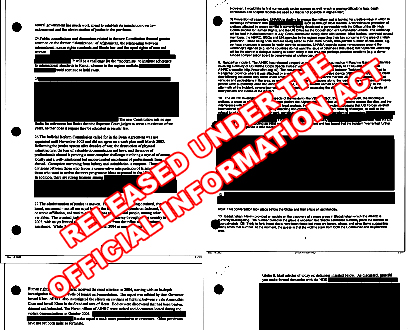1982 classics: The Dark Crystal, Blade Runner, and the Official Information Act
 In November 2022, the Leaders Integrity Forum organised by Transparency International New Zealand paid homage to the Official Information Act 1982 (the OIA). The OIA has become an essential part of the constitutional arrangements in New Zealand, playing a key role in maintaining New Zealand’s reputation as a trusted and trustworthy nation.
In November 2022, the Leaders Integrity Forum organised by Transparency International New Zealand paid homage to the Official Information Act 1982 (the OIA). The OIA has become an essential part of the constitutional arrangements in New Zealand, playing a key role in maintaining New Zealand’s reputation as a trusted and trustworthy nation.
Openness and transparency of decision-making contributes to accountability and to New Zealanders’ trust and confidence in our public sector. We can be rightfully proud of our legislation to safeguard the freedom of information. However, there is some mistrust in the OIA process, and certainly room to improve how it is given effect to.
While the OIA is often see as the domain of lawyers, public sector leaders can make a critical difference in modelling openness and transparency. This was the focus of the discussion, led by speakers Peter Boshier (Chief Ombudsman) and Dean Knight (Associate Professor, Faculty of Law, Victoria University of Wellington).
The OIA is there to hold Ministers and officials accountable, promoting transparency in policy and law-making while protecting confidential information. Each chief executive has a critical role: they have specific stewardship responsibilities in fostering open government, building long-term OIA capability, and upholding laws that their agencies administer.
In general, OIA compliance has improved. Agencies are increasingly proactive in releasing information and attending more quickly to requests. Peter noted that the regular 1pm media briefings during the pandemic showed how proactive information sharing is both beneficial and important. Openness can play a key role in getting public buy-in on major government policies and decisions.
However, Peter noted weaknesses in how agencies are responding to OIA requests. The maturity of OIA processes varies between agencies. The media have reported that, as a whole, the process takes too long and it can be difficult to request information from agencies. There are also gaps around the stewardship of official information, clarity around OIA compliance, and developing a longer-term view of maintaining and growing OIA capability.
In Peter’s view, chief executives should see the OIA as an opportunity to improve their agency’s transparency. Peter suggested several actions for a chief executive to take:
- First, commit to a culture of openness, for staff and the public. Model that openness by publishing any “no surprises arrangements” with Ministers’ offices, as well as the agency’s process and track record on OIA compliance.
- Second, separate media requests from other OIA requests. Media requests tend to be more urgent, yet some receive the same “response within 20 working days” timing as other OIA requests. This has led to an understandable tension between agencies and the media.
- Third, don’t take a blanket approach in applying the “no surprises” rule, notifying the Minister’s office of every request under the OIA. This slows down the process and risks suspicion of political interference. One way of keeping the Minister informed while keeping the OIA process moving is to notify the Minister’s office at the same time (or just before) the request is sent back.
Dean agrees with Peter on the importance of transparency – it underpins the legitimacy of elected representatives. The OIA framework is overall discretionary and nimble, so changing the legislation is unlikely to be needed.
However, Dean thinks the prominence given to the OIA has crowded out broader conversations about transparency. A transparent culture is more than compliance – it also includes prudent decision-making.
With OIA requests:
- Information should be made publicly available unless there is good reason not to.
- Apart from the speed of reply, media requests should not be treated differently to other OIA requests – the potential for media to “expose” an agency should not prevent a transparent response.
Dean suggested a few ways in which an agency could improve its culture of transparency:
First, don’t conflate compliance with formality. A less formal process to quickly reply to a media OIA request can comply with the principles of the OIA, if done properly.
It can help to have a “champion of the OIA” in every agency, an independent position designed to maintain OIA compliance. Another idea is ensuring that Minister’s offices – particularly political advisors – are sufficiently trained on both the constitutional and operational aspects of dealing with OIA requests.
Second, it is important that OIA and correspondence teams are sufficiently resourced. Given the speed of media cycles and turn-around expectations, it may be a good idea to properly invest in information-retrieval technologies and practices (and consider a separate, protected, funding envelope for OIA compliance and transparency).
Ultimately, being good stewards of the OIA takes courage and continuous improvement in our practices. As difficult as this work is, it is integral for us as public servants – not only to maintain our standing as one of the world’s most transparent nations, but also to uphold our country’s constitutional foundation.
It’s a long time since 1982; we need our crystals to be clear, not dark.
